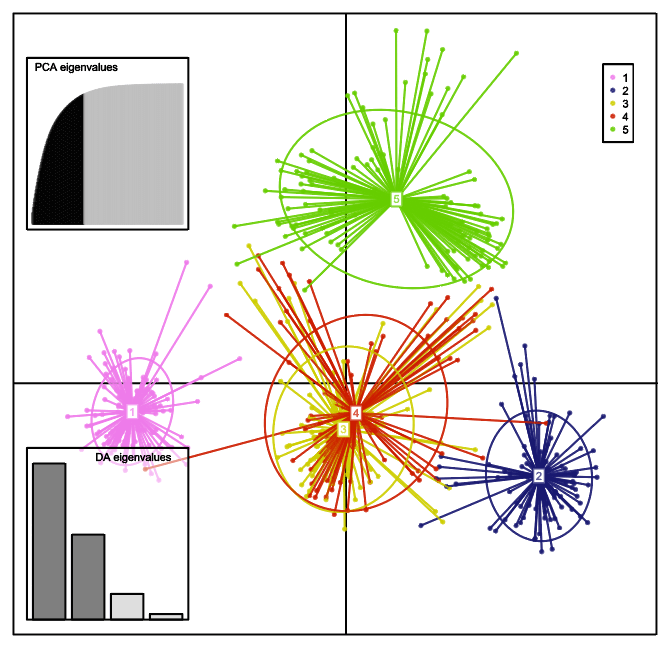The genetic variability of the honeybee population in the Czech Republic had not been thoroughly studied before. This motivated a team of scientists from the Faculty of Agronomy to create a representative sample.
“We divided the entire Czech Republic by regions and districts, collecting an equal number of samples from each geographical area. This resulted in a unique database containing over 5,000 bee samples from across the country,” explained Tomáš Urban from the Institute of Morphology, Physiology, and Animal Genetics at Mendel University in Brno.
With this dataset, scientists were able to systematically analyze the genetic diversity of bees in the Czech Republic. “Historically, the so-called black bee, Apis mellifera mellifera, was traditionally adapted to the area of today’s Czech Republic. Around 200 years ago, a new bee type was gradually imported from the south, from what is now Croatia and Slovenia. This was the Carniolan honeybee, Apis mellifera carnica, which was less aggressive and had higher honey yields. Through mitochondrial DNA analysis, we found that the haplotype of the black bee is no longer present in our samples,” Urban described, suggesting that the native species once typical for the region has likely disappeared.
The historical import of bees from southern Europe had a breeding purpose, but molecular genetics is now expanding its potential. Thanks to the newly developed genetic database, scientists have not only mapped the diversity of honeybee mitochondrial and nuclear DNA in the Czech Republic but also identified genetic differences in individuals that may have higher resistance to diseases. This could be useful in future breeding efforts, particularly against Varroa destructor infestations.
“In Germany, England, and the Nordic countries, there have been efforts to gradually increase the resistance of bee colonies, but practical success has been limited so far. This is due to the complexity of the bee immune response and behavioral traits. That is why it is necessary to systematically search for genes that may be responsible for better resistance to pathogens. This was another key part of our research,” Urban added.
The research team has developed certified methodologies for testing individual bees using microsatellite markers. These markers allow for the identification of bees and the monitoring of their genetic variability in populations. The second methodology can also help identify bees that may have higher resistance to pathogens—an essential step for future breeding programs focused on Varroa resistance.
For more information, contact: Prof. Ing. Tomáš Urban, Ph.D., tomas.urban@mendelu.cz, +420 545 133 182, Institute of Morphology, Physiology, and Animal Genetics, Mendel University in Brno

Estimated genetic clusters representing population structure
More news
-
Mendel University in Brno is the main coordinator of an international project focused on the protection and conservation of narrow-leaved ash (Fraxinus angustifolia), a key tree species in the floodplain forests of Central and Southern Europe.…18. 12. 2025
-
MENDELU coordinates activities for biodiversity conservation and sustainable…
The Faculty of AgriSciences and the Faculty of Forestry and Wood Technology at MENDELU are coordinating an international project in the Amazon that contributes to biodiversity conservation, sustainable management, and improving quality of life. This…16. 12. 2025 -
MENDELU launches High School University, applications open today
At the beginning of 2026, Mendel University in Brno will launch the first year of its High School University for second- and third-year high school students. The aim is to give twenty-five high school students a glimpse into the university…8. 12. 2025 -
The popularity of intergenerational learning is growing in Czechia and Slovakia
In December, Mendel University in Brno and the University of Žilina in Žilina are continuing their intensive cooperation on the development of intergenerational programs, which have been growing in popularity in both countries in recent years. The…4. 12. 2025 -
Testing VR Application at Mendel University: Innovation in Water Education
During the international Thematic Lecture „DIGITALISATION AND NATURE-BASED-SOLUTIONS FOR WASTEWATER TREATMENT“ event for water management experts, organized by the CREA Hydro&Energy cluster, experts tested a new VR application focused on teaching…3. 12. 2025 -
Superworms under the microscope: Scientists at the Faculty of AgriSciences are…
A team of scientists at Mendel University in Brno is investigating how larvae of the darkling beetle species Zophobas morio are able to break down various types of plastics. The aim is to elucidate in detail the biodegradation mechanisms of the…2. 12. 2025 -
Nine hundred Christmas trees from Křtiny will be sent to the Brno Christmas…
For the second year running, the Masaryk Forest Křtiny School Forest Enterprise (ŠLP Křtiny) is continuing its collaboration with the Brno-based non-profit organization Veronica Foundation as part of a project to sell potted Christmas trees. This…19. 11. 2025 -
The scientific team at the Faculty of Horticulture is working to protect the…
The almond orchards in Hustopeče are unique in Europe, but similar to grapevines, the wood of stone fruits, which include almonds, can be attacked by pathogenic fungi. Trees can be protected by following proper agrotechnical practices, especially by…13. 11. 2025 -
The Academic Senate elected Martin Klimánek as the new rector
Today, the Academic Senate elected Martin Klimánek, the current Vice-Rector for Strategy, Sustainability, and Special-Purpose Activities, as the new Rector of Mendel University in Brno. He will replace Jan Mareš at the helm of the university on…3. 11. 2025 -
Plant growth is significantly influenced by volatile substances produced by…
This groundbreaking discovery was made by scientists from Mendel University in Brno and their colleagues from the University of Cologne. The scientific team focused on the role of volatile organic compounds, which serve as signaling molecules…31. 10. 2025